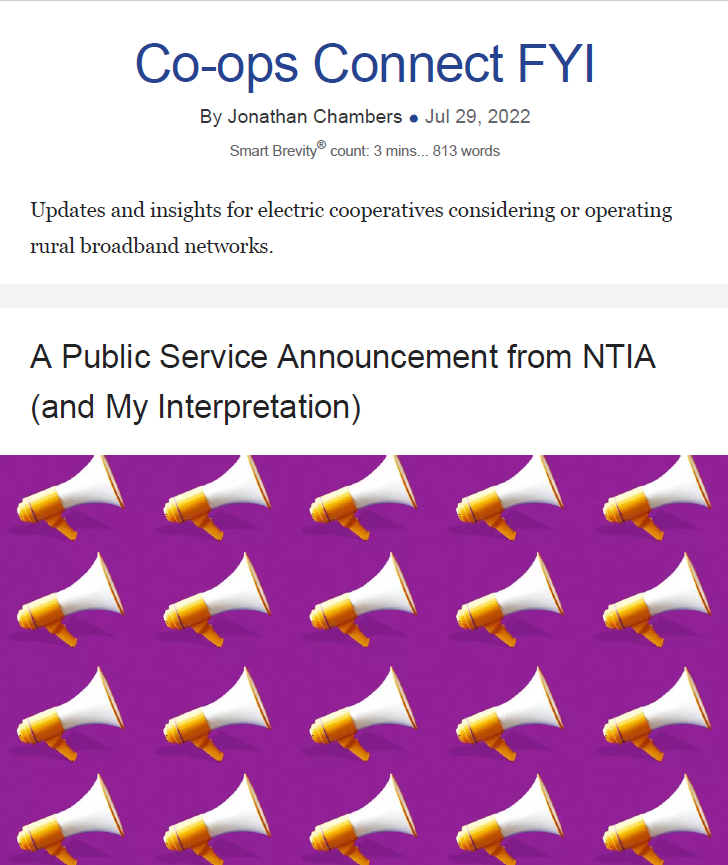A Public Service Announcement from NTIA (and My Interpretation)
July 29, 2022
The National Telecommunications and Information Administration (NTIA) wants you to know the following:
- “NTIA is responsible for awarding $48 billion to enable every person in America to have access to affordable, reliable, high-speed internet.”
- “Congress required NTIA to rely upon the Federal Communications Commission’s (FCC) forthcoming National Broadband Map to develop budget allocations for each state and territory.”
- “Knowing where to distribute these funds is central to the process, which is why Congress required NTIA to rely upon the FCC’s forthcoming National Broadband Map to develop budget allocations for each state and territory. This new map will provide a comprehensive, standardized, highly granular location-by-location picture of broadband availability nationwide.”
- “Internet service providers must submit their availability data for the initial Broadband Data Collection filing round no later than September 1, 2022.”
The bottom line, according to NTIA:
“Companies who do not timely submit their Broadband Data Collection and FCC Form 477 data in the correct format to the FCC will be ineligible for Broadband Equity, Access, and Deployment (BEAD) Program subgrants in the states in which they operate. Moreover, if a company’s broadband availability data are not accurately reflected in the FCC’s map, that company runs the risk of being overbuilt by BEAD recipients or future FCC, federal or state broadband infrastructure funding programs. These adverse effects are in addition to FCC enforcement action and/or penalties that may result from an ISP’s failure to timely submit accurate and complete data to the FCC.”
This Is What It Means for You
Let’s break down NTIA’s statements:
1. Of the $48 billion, $42.45 billion is to be allocated to the 50 states and U.S. territories for state rural broadband programs that will be reviewed and approved by NTIA.
- The rest of the funding is divided into a $1 billion NTIA middle mile program and state and federal digital equity programs.
2. The $42.45 billion rural broadband funding will be allocated to states according to a simple formula that indeed depends on new FCC maps.
- After 10% of the funding is allocated to high-cost areas in states, the remaining funding will be allocated according to each state’s percentage of “unserved” locations.
- The ratio of unserved locations in a state compared to the unserved locations in the nation will be used to allocate the funding, though small states like Vermont and Delaware are guaranteed at least $100 million.
3. “Unserved” is defined in the Infrastructure Act as a broadband-serviceable location that lacks access to reliable broadband, which is a speed not less than 25 Mbps downstream, 3 Mbps upstream and latency sufficient to support real-time interactive applications.
4. “Underserved” is defined in the Infrastructure Act as a broadband-serviceable location that lacks access to reliable broadband, which is a speed not less than 100 Mbps downstream, 20 Mbps upstream and latency sufficient to support real-time interactive applications.
5. The state funding allocation, dependent on the FCC’s maps, is a ratio of “unserved” locations.
- Areas with “underserved” locations may be funded by states, but only the FCC’s maps of unserved locations are to be used for the allocation.
6. The FCC’s semi-annual data collection of internet availability, using FCC Form 477, has been supplemented by a second set of data requests, called the Broadband Data Collection. Both the 477 and BDC are due September 1.
7. The main difference in the new data collection is the requirement of location specificity.
- What’s new: An ISP must submit a shapefile or a CSV using the FCC’s new location fabric, which purports to identify the exact place of every broadband-serviceable location in the country.
- In prior years, ISPs reported a list of census blocks where service was available.
8. The FCC assumes certain distance limits for different transmission media:
- 6,600 route feet from the DSLAM to customer premises for 25/3 Mbps DSL.
- 12,000 route feet from an aggregation point to customer premises for hybrid fiber coax.
- 196,000 feet from OLT to ONT for fiber networks.
- Fixed wireless providers must provide propagation maps and other detailed network information.
9. As before, ISPs must report the maximum advertised speed.
- Yes, but: There are no requirements that an ISP demonstrate that advertised speeds are actual speeds.
10. States are free to use their own maps for their broadband plans and have been encouraged by NTIA to collect such data.
- Yes, but: Despite flaws in the FCC’s methodology, to date no state map has come close to the comprehensiveness or accuracy of the FCC’s current data collection.
The Bottom Line
While Conexon is timely submitting our data and the data of dozens of electric co-ops to the FCC, the more important work will come later in the challenge process.
We are preparing to challenge both the location fabric and the claims of service in electric co-op service territories.
Participating in the challenge process is the best way to protect your electric service territory.
